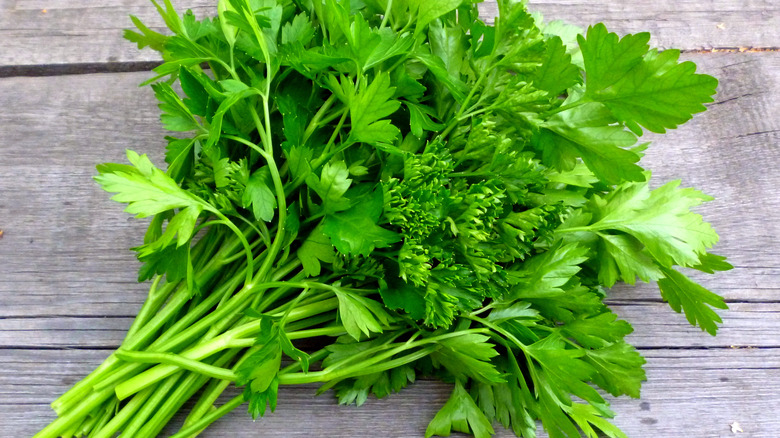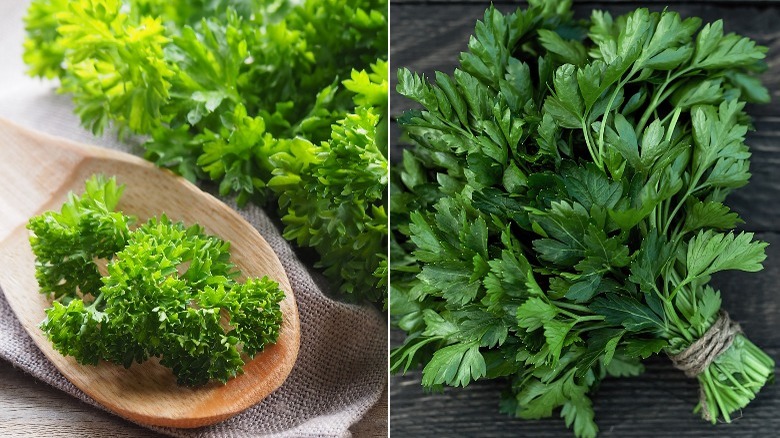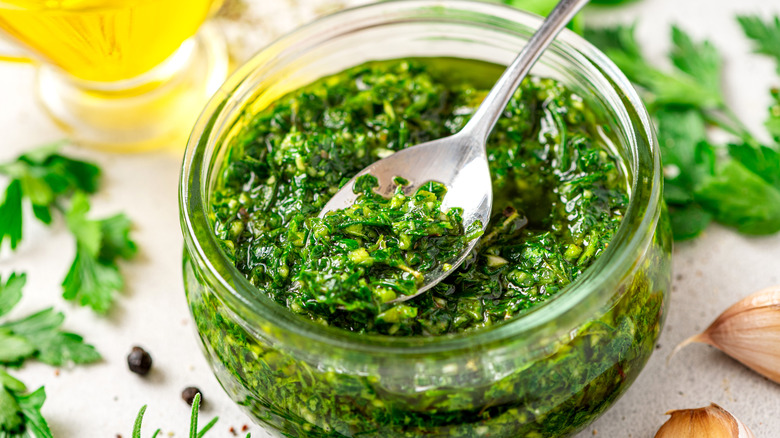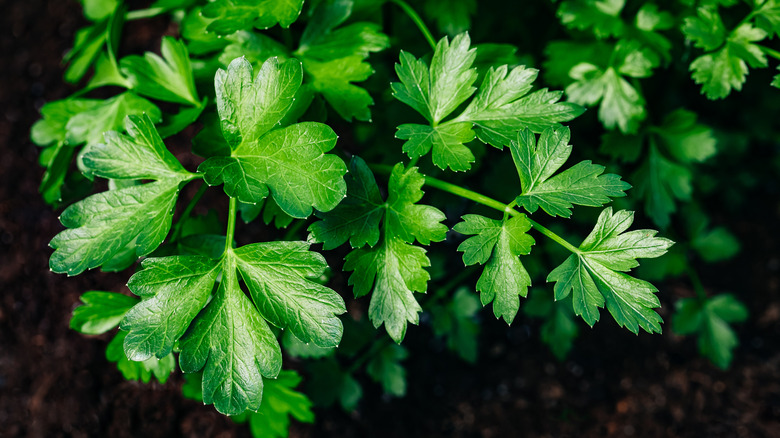What Is Italian Parsley And What Does It Taste Like?
Parsley is a pervasive, super popular herb that adds color, brightness, and a familiar pop of flavor to a multitude of dishes — and its proper name is petroselinum crispum var. neapolitanum, according to Magic Garden Seeds. For some, it can be a tricky herb to get a handle on, especially considering its multiple varieties: parsley, flat-leaf, Italian, French (also known as chervil), etcetera. Interestingly enough, though, Italian and flat-leaf are actually the same type of parsley, just with two distinct names.
Sometimes a mere garnish and other times an integral ingredient within a dish, parsley is multifaceted. Flat-leaf or Italian parsley is known for its thin stems and, well, flat leaves, which Bon Appétit calls "serrated." The herb is also sold dried, but it is available year-round and much more flavorful when fresh, per The Spruce Eats. Shoppers can find both conventional and organic parsley sold in large bunches in most grocery stores.
Curly vs. Italian (or flat-leaf) parsley
Spiceography notes that the "Italian" portion of this herb's name exists simply because this parsley hails from Italy. Italian parsley became popular in the U.S. in the 1970s, where, previously, mostly curly parsley from France was used. Later on, the term "flat-leaf parsley" became a common name for the Italian variety. Obviously, one of the main differences between curly vs. flat-leaf parsley is the appearance of the leaves. The former appears more ruffly, while the latter is straight and flat.
It should also be noted that flat-leaf parsley is more flavorful and preferred by chefs for cooking. For this reason, flat-leaf or Italian parsley is ideal for use within a recipe, while the milder curly parsley is best as a garnish or for uncooked dishes. There's certainly an overlap in the tasting notes between the two, though, so if you only have one on hand, they should be fine to use interchangeably.
What does Italian parsley taste like?
Bon Appétit states that for the best flavor, Italian parsley should be purchased when bright and verdant, with no wilting or yellowing of the leaves. Also, be mindful not to mix up flat-leaf parsley with cilantro at the grocery store, as they have vastly different flavors and aromas but look very similar. Parsley can also be a bit more palatable than cilantro, which — of course — has taken on quite a polarizing status.
The flavor of Italian parsley is clean, fresh, and somewhat grassy, and it can add a slightly spicy flavor to dishes in a similar way to pepper. The Spruce Eats notes that it's often paired with butter, lemon, and garlic and used everything from rubs and marinades to sauces and pestos. When used in small amounts, it can brighten up a dish, such as green juice or garlic bread. The more you use, the stronger it will taste, as is the case in a parsley-heavy recipe like chimichurri. Most recipes call for parsley leaves only, but the stems can also be chopped along with the leaves. In fact, Kitchn states that the stems are oftentimes more flavorful than the leaves. Even if you decide not to use them in your recipe, you can save them for homemade vegetable stock.
Nutritional information about Italian parsley
From a health perspective, Real Simple note that parsley contains calcium, antioxidants, and vitamins A, C, and K. These nutrients are beneficial for eye, heart, gastrointestinal, and bone health, as well as immunity. Parsley can also help prevent inflammation and eye problems, and it has been shown in some cases to fight cancer and the development of diabetes. While most dishes don't use exorbitant amounts — especially if it's just a garnish — parsley is always a welcome choice, from flavor and color to health benefits.
In order to get the best flavor and nutritional benefits from your Italian parsley, it's important to use and store it properly. As noted by The Spruce Eats, it's important to add it to the dish just prior to serving when it's more robust. To keep it fresher for longer, store it in a damp paper towel in a plastic bag, instructs Bon Appétit. Otherwise, you can freeze your herbs to have on hand whenever you want a bright and peppery parsley punch.



